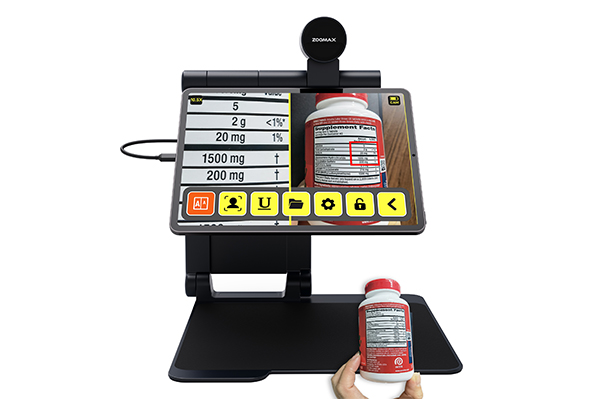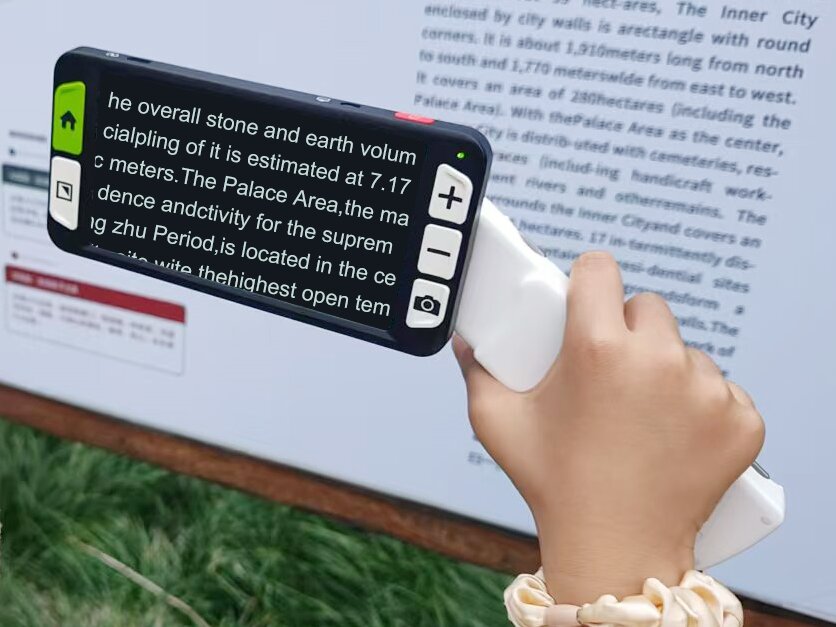With the rapid advancement of technology and the global aging population, low vision and visual impairments have become increasingly important issues for many individuals and societies worldwide. According to the World Health Organization (WHO) 2024 report, approximately 250 million people globally are affected by low vision or visual impairments. As technology continues to improve, the quality of life for people with low vision has significantly enhanced, and the market for low vision assistive technology is witnessing unprecedented growth opportunities. Low vision solutions, particularly smart assistive devices, not only improve the quality of life for individuals with low vision but also represent an emerging industry with substantial investment potential. This article will explore investment opportunities in the low vision sector and invite potential partners to join our distributor network to help advance the accessibility solutions for low vision individuals.
Investment Potential in the Low Vision Industry
According to a 2023 market research report, the global market for low vision assistive devices is expected to reach $10.5 billion by 2028, with a compound annual growth rate (CAGR) of 7.9% (MarketsandMarkets, 2023). This growth is primarily driven by the following factors:
- Aging Population: According to a United Nations report, the number of people aged 65 and older worldwide is expected to exceed 1.6 billion by 2050, compared to 1 billion in 2020. As people age, the incidence of low vision among the elderly population increases significantly (United Nations, 2023).
- Prevalence of Visual Problems: In developed countries, vision issues due to prolonged use of electronic devices have become increasingly common, including screen syndrome and digital eye strain. This creates a large demand for low vision assistive technologies (Vision Council, 2023).
- Technological Advancements: With the development of digital technologies, low vision assistive devices now go beyond traditional magnifiers and optical devices. More electronic products, such as devices with OCR text recognition, smart voice features, and smart glasses, are revolutionizing the lives of people with low vision (Low Vision International, 2023).
As the demand for low vision solutions continues to grow, the market is expected to expand rapidly in the coming years, offering significant business opportunities and profitability for investors.
Strategic Importance of Investing in Low Vision Solutions
The low vision industry offers not only social benefits but also significant economic potential. According to a 2023 report, the low vision assistive technology market is expected to exceed $10 billion by 2028, with key drivers including the aging population, technological advancements, and the growing demand from individuals with visual impairments (Grand View Research, 2023). Investing in low vision solutions can provide excellent returns while making a positive impact on society.
Low vision assistive devices are no longer limited to traditional magnifiers or basic optical tools. With technological innovation, low vision devices now include OCR text recognition, voice output, smart image processing, and more. According to a 2023 report from the American Foundation for the Blind (AFB), over 40% of individuals with low vision are currently using some form of assistive technology to enhance their quality of life, and this number is expected to continue growing.
Zoomax: Leading the Way in Low Vision Technology
As one of the leading brands in low vision assistive devices, Zoomax is dedicated to providing innovative solutions for individuals with low vision. Our product line includes everything from portable magnifiers to smart glasses, helping low vision individuals worldwide regain their independence and confidence in daily life.

Snow 12
The Zoomax Snow 12 is a high-resolution 12-inch portable electronic video magnifier, specifically designed for low vision users who require detailed work and long reading sessions. It features OCR text recognition and voice output, allowing users to easily read text, images, and diagrams, significantly reducing eye strain.

Snow Pad
An innovative touchscreen electronic reader, the Snow Pad is compatible with its own pad device, supporting the magnification of text, images, and charts, with personalized vision optimization options. Its touch controls are user-friendly, making it ideal for long reading, office work, and study, especially favored by students and those using it for leisure activities. The Snow Pad also includes OCR functionality, further enhancing convenience for low vision users.
Luna 6
 The Zoomax Luna 6 is a 6-inch handheld electronic video magnifier with high-resolution display and portability, ideal for outdoor use. It also supports wireless charging and features simple controls, making it a favorite among low vision users.
The Zoomax Luna 6 is a 6-inch handheld electronic video magnifier with high-resolution display and portability, ideal for outdoor use. It also supports wireless charging and features simple controls, making it a favorite among low vision users.
These products from Zoomax are widely used and highly rated in various settings, including education, office work, and home environments. They help low vision users enhance their independence and confidence in daily activities.
Why Invest in Low Vision Solutions?
1. Market Demand and Growth Potential
According to a 2023 report by GlobalData, the low vision assistive device market is expanding at an approximate growth rate of 8% annually. With the aging population worldwide, particularly in Asia and Europe, low vision solutions will be a major driver of market growth. Investing in the low vision sector presents a prime opportunity to tap into this expanding market.
2. Sustainable Social Impact
Investing in the low vision sector not only offers financial returns but also allows businesses to make a positive social impact. Low vision assistive technologies significantly improve the lives of people with visual impairments, helping them regain independence. According to the World Health Organization (2023), providing low vision solutions has a profound impact on societal welfare by reducing the inconvenience of the aging population and empowering them with more independence through technology.
3. Technological Innovation and High Added Value
Low vision assistive devices are no longer simple magnifying tools. With technological advancements, devices now feature OCR text recognition, voice output, smart image processing, and more. According to a 2023 report from Low Vision International, user satisfaction with smart low vision assistive devices has reached over 85%, demonstrating the high added value that technological innovation brings.
Join Our Distributor Network
As a global leader in low vision assistive devices, Zoomax is seeking new partners to join our distributor network. If you’re interested in entering the rapidly growing low vision market, becoming a Zoomax distributor is your best opportunity. We provide comprehensive support to our distributors, including marketing materials, sales training, and product guarantees, to help you establish a strong foothold in the low vision market.
We look forward to partnering with you to promote the development of low vision assistive technology and help low vision individuals worldwide. Click here to apply to become a Zoomax distributor.
Conclusion
The low vision assistive technology sector is not only a market with immense growth potential but also an industry that brings significant social benefits. With its innovative products and excellent customer service, Zoomax has established itself as a leader in the global low vision technology market. If you want to join this rapidly growing sector and become a distributor for Zoomax, it is the first step toward success.
By joining our distributor network, you will not only provide valuable help to people with low vision but also open new growth opportunities for your business. Let’s work together to shape the future of the low vision industry.
If you have any questions about our products or partnership opportunities, please feel free to contact us. We look forward to building a long-term cooperative relationship with you and helping low vision individuals live better lives.
Frequently Asked Questions (FAQs)
1. What is the low vision assistive technology market?
The low vision assistive technology market refers to the sector focused on developing and distributing devices that aid individuals with visual impairments. This includes electronic magnifiers, smart glasses, portable video magnifiers, and devices with optical character recognition (OCR) to help people with low vision read, navigate, and perform daily tasks. The market is expanding rapidly due to the increasing prevalence of low vision and the aging population worldwide.
2. Why should I invest in the low vision industry?
Investing in the low vision industry offers both financial and social benefits. The market is growing steadily, driven by technological innovations and an aging global population. Additionally, low vision assistive devices significantly improve the quality of life for millions of people, making your investment not only profitable but also impactful by helping people regain independence and participate more fully in society.
3. What are the key drivers of growth in the low vision assistive technology market?
Key drivers of growth include:
- The aging population, with more elderly individuals requiring low vision solutions.
- Technological advancements in assistive devices, such as OCR, voice output, and smart features.
- Increasing awareness and demand for products that enable people with low vision to work, study, and engage in daily activities independently.
- The rise in visual impairments caused by prolonged screen time and digital eye strain.
4. Is there a growing demand for low vision assistive technology?
Yes, the demand for low vision assistive technology is increasing due to the global aging population and the growing awareness of visual impairments. The low vision market is expected to reach $10.5 billion by 2028, with a steady compound annual growth rate (CAGR) of 7.9% (MarketsandMarkets, 2023). This indicates a strong market presence and continued expansion in the coming years.
5. How can investing in low vision solutions impact society?
Investing in low vision solutions can have a profound social impact by improving the lives of individuals with visual impairments. These technologies enable people to regain independence, participate fully in society, and enhance their overall quality of life. Furthermore, investments in this sector can promote inclusivity and accessibility for individuals of all ages and backgrounds.
References
MarketsandMarkets. (2023). Low vision assistive technology market by type, application, and geography – Global forecast to 2028. Retrieved from https://www.marketsandmarkets.com
National Eye Institute. (2023). Age-related macular degeneration: A growing concern in an aging population. Retrieved from https://www.nei.nih.gov

